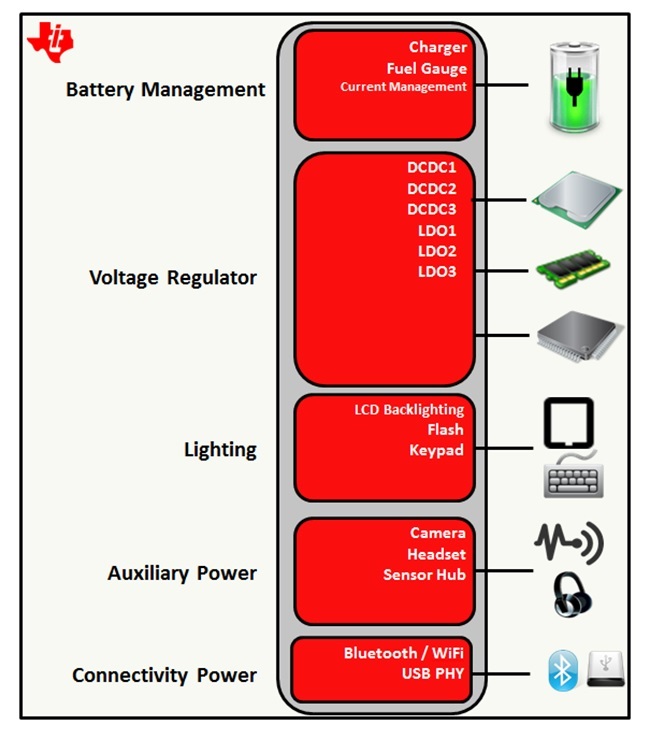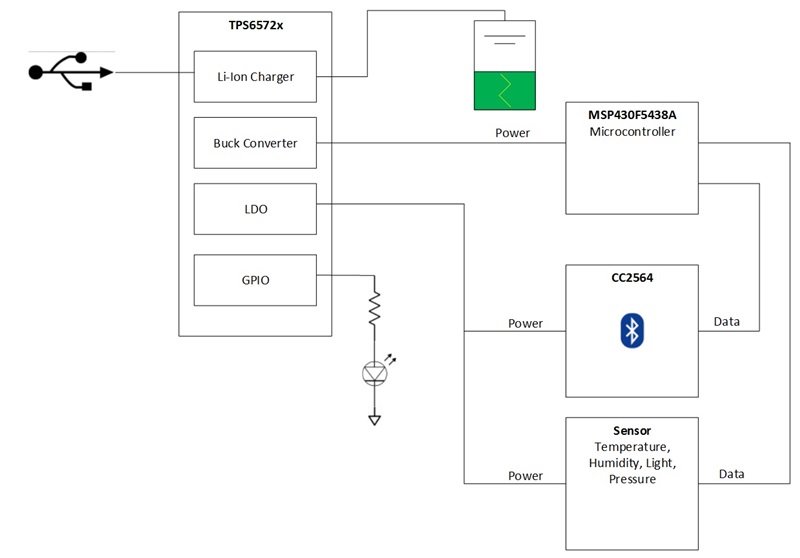Shortening time to market is a key requirement for any wearable or Internet of Things (IoT) design, such as smart watches, data loggers, sensors, home gateways and more. Many designers are looking for the simplest and quickest way to implement these systems. The challenge seems simple, but is it?
Most basic systems contain a microcontroller, sensors and some type of wireless connectivity, often with different supply-voltage requirements. If you are designing for a portable device, you may need to make your design battery-operated or run on energy harvesting. Suddenly, your simple, one-rail system is a more complex multirail power design that needs a battery charger. What do you do now?
If complexity, size and integration aren’t factors, you could use a buck converter for the main power, a low-dropout regulator (LDO) for the other voltage rail and a lithium-ion (Li-ion) charger to charge the battery. Three power ICs, along with all external discrete components, adds system complexity, size and cost.
Why not try a power-management multichannel IC solution (PMIC) instead? Small, easy-to-use PMIC solutions can range from two simple power rails to 26 rails with load switches, analog-to-digital converters (ADCs), battery chargers, LED drivers and other combinations. They are cost-efficient and speed time to market because all the components are flexible and included in a single solution. See Figure 1 to see how a PMIC solution works.
Figure 1: PMICs can be highly integrated, including more than just power. PMICs integrate devices that are usually external, such as liquid crystal display (LCD) backlighting, real-time control, sequencing, and battery chargers.
An example of a PMIC designed for wearable and IoT applications is the TPS6572x. This small device has a 300mA integrated Li-ion charger, a highly efficient buck converter, 200mA for TPS65720 or 400mA for TPS65721 and a 200mA LDO. The voltages are easily set by an external resistor divider. The TPS6572x also integrates four general-purpose input/outputs (GPIOs) so you can free up some space on your microcontroller and make routing easier for things like light-emitting diodes (LEDs) and buzzers often used in fitness watches and portable industrial applications. The TPS6572x comes in a WCSP (TPS65720) package or a QFN (TPS65721) package. The TPS65720’s total solution size with discrete components is 25mm2 .
Figure 2 shows a simple block diagram of how this solution can work using an industrial data-logging application. The TPS6572x powers the microcontroller, Bluetooth® controller and sensor, creating a low-power, small and efficient design.
The ultra-low-power MSP430F5438A MCU supports TI’s Energy Trace™ technology, an advanced energy-debugging ecosystem. Energy Trace technology allows users to view energy consumption in real time by seeing the breakdown of active, standby and peripheral power. Using the MSP430F5438A MCU allows the system to detect and log sensor data continuously and make autonomous decisions while only waking up wireless radios such as the dual-mode CC2564 Bluetooth controller. The CC2564 device leverages the communication and power-savings mode of the MSP430 MCU in order to consume the least amount of power. The CC2564 Bluetooth device acts as an Internet gateway linking to your smartphone, tablet or PC to collect real-time data from the sensor and the system. The TPS6572x powers the entire system with just two simple rails and provides USB battery charging.
Most devices rely on push buttons for a sleep or wakeup event. The TPS6572x has push-button detect, which can tell the rest of the system to go into deep sleep, conserving energy, or wake up to continue operation. Together, these devices create a small, efficient battery-powered application. The devices can be used together in applications like fitness bands, heart-rate monitors, industrial data loggers and industrial sensors.
Using a PMIC to power multi-rail systems enables flexible, simpler, efficient and smaller designs. Our PMICs can power subsystems, the main processor, or the main processor and subsystem. Next time you have multiple power rails on your application, think about a PMIC.
Figure 2: Simple devices often use multiple power rails. The multirail output of the TPS65721 enables small, efficient designs.
To learn more about what PMICs and other TI solutions can do for your wearable and IoT applications, check out these additional resources:


